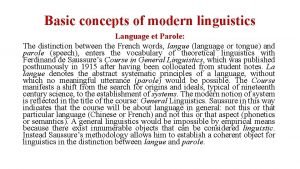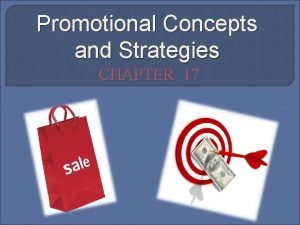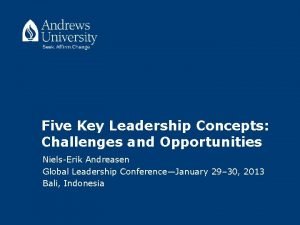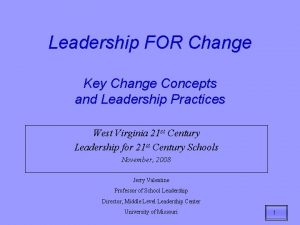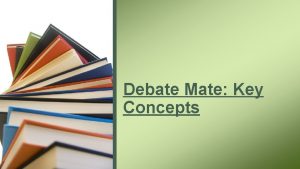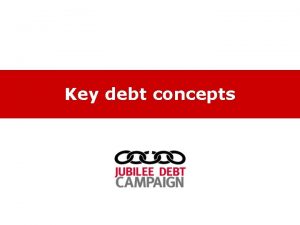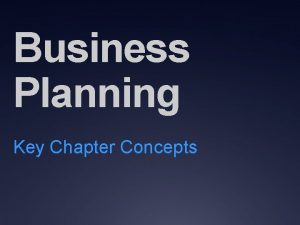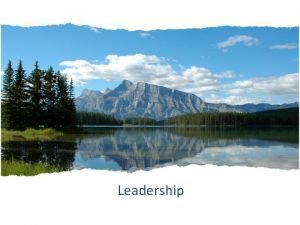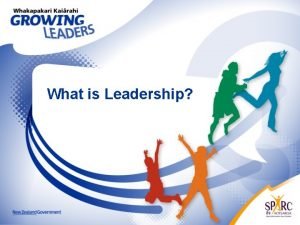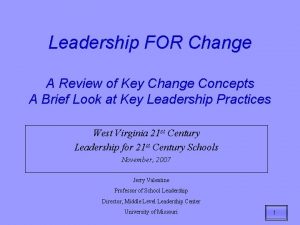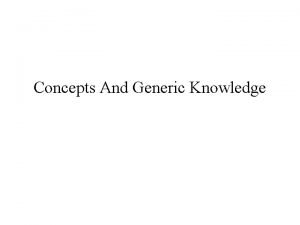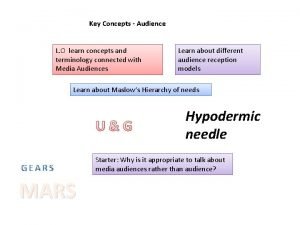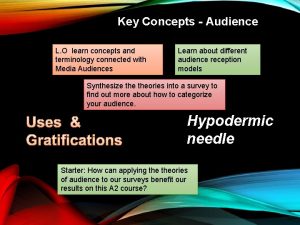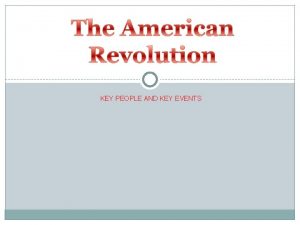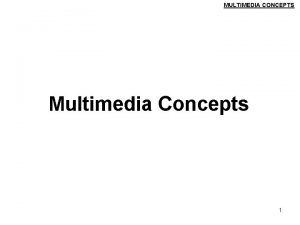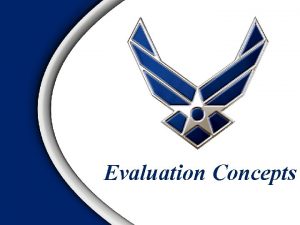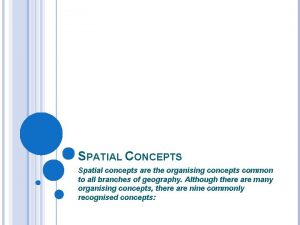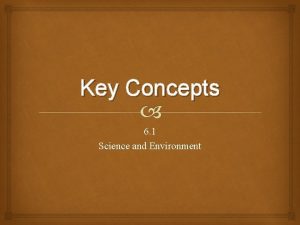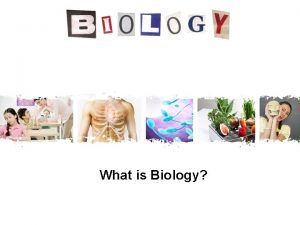Leadership FOR Change Key Change Concepts and Leadership



































- Slides: 35

Leadership FOR Change Key Change Concepts and Leadership Practices West Virginia 21 st Century Leadership for 21 st Century Schools November, 2008 Jerry Valentine Professor of School Leadership Director, Middle Level Leadership Center University of Missouri 1

2

Jerry’s Baseball Lexicon Situation: Bottom of the ninth, runners on first and third, one out, losing by one run; there is urgency in our effort to succeed together—so I need feedback! 1. Struck out looking; 1. I do not really two out; up to next understand what your batter mean 2. Hit into a double play; 2. I understand clearly and game over I completely disagree 3. Single; game tied 3. I think I understand 4. Ground rule double; 4. I understand clearly and game tied; winning run agree; I will give this on third; still 1 out some deep thought 5. Home run; home team 5. I understand, agree, and wins will find a way to apply it 3

Leadership Matters • Chuck’s presentation confirmed unequivocally that… LEADERSHIP MATTERS to school and student success! • So, let’s look at “Leadership FOR Change” for a few minutes… • Let’s begin with this concept: “If you are not improving, you are declining” 4

Why We Must Change: The Knowledge-Implementation Gap ta s n Co & ntly to s d ee t p a Ad c u d E N n o ati es c i t rac l. P a n io t s a e c g s n du e a E c i h t t C s c e a P y r t B E e P f i B l o f a o e n Soc e g o i g t ed a l ed c l w u w o d o n E K t Kn t s r n e i e B ta f n i o Exp a P e E M B g f o e d ge le W d e f l w i w o o n Kn on i K e t t a r t e n od Ou e M / w m le on i t p a t n m e I Our Implementation with No New Knowledge No New Kno wledge, Low Effort 5

Baseball Metaphor Feedback: Knowledge-Implementation Gap 1. Struck out looking; two out; up to next batter 2. Hit into a double play; game over 3. Single; game tied 4. Ground rule double; game tied; winning run on third; still 1 out 5. Home run; home team wins 1. I do not really understand what your mean 2. I understand clearly and I completely disagree 3. I think I understand 4. I understand clearly and agree; I will give this some deep thought 5. I understand, agree, and will find a way to apply it 6

Lewin’s Freeze/Unfreeze/Transition/Refreeze Model of Change 7

Mountain Stream Ice Flow: Freezes, Thaws, Reshapes, Refreezes with the Environmental Factors of Sun-Shade-Current Flow-Water Depth 8

Freeze-Unfreeze-Transition. Refreeze Explanation • Freeze is our current state—the way we are… • Unfreeze is the time we spend realizing and accepting that we need to change. • Transition is the actual implementation of the change • Refreezing is stabilizing the organization so the new change can be internalized and maintained until it needs to be changed • Learning organizations are in a continuous cycle of change from freeze to unfreeze to transition to refreezing just as the mountain stream transitions in the fall or spring 9

Same Concept, Different Visual Lewin’s Stages of Change: Current State Unfreeze Transition Freeze 10

Baseball Metaphor Feedback: Freeze-Unfreeze-Transition-Refreeze Cycle 1. Struck out looking; two out; up to next batter 2. Hit into a double play; game over 3. Single; game tied 4. Ground rule double; game tied; winning run on third; still 1 out 5. Home run; home team wins 1. I do not really understand what your mean 2. I understand clearly and I completely disagree 3. I think I understand 4. I understand clearly and agree; I will give this some deep thought 5. I understand, agree, and will find a way to apply it 11

Low Comfort with High Staff Anxiety Comfort-Discomfort-Comfort Cycle: Staff Anxiety During 2 nd Order Change Optimism with Decision to Change current conditions Persistence Realization of needed change Realization of urgency for change Comfort w/ ongoing change Engagement & Problem Solving Frustrations of implementing the change TIME 12

2 nd Order Change and Rationalizations Against It • 2 nd Order Change requires a significant departure from the norm and often means a shift in status or power. – Comment: Why change. The way we have always done it works! – Which really means: I don’t want to change that much. And I resent those young teachers with their new ideas. • 2 nd Order Change is a threat to personal values, beliefs, and abilities. – Comment: That will be a lot of work. Why change that much? I just don’t believe it’s the right thing to do. – Which really means: I do not believe most kids can learn even if we make the change. We will never get “those kids” to learn. • 2 nd Order Change is a slow, evolving process over time. – Comment: This takes too much time and I have too many things to do now. Besides, I plan to retire real soon. – Which really means: I don’t want to work that hard at this stage in my career. I am considering retirement, maybe in the next 13 several years.

2 nd Order Change and Rationalizations Against It • 2 nd Order Change addresses complex problems requiring new, thoughtful, and often creative comprehensive solutions. – Comment: This new change may be too hard for all of our faculty to learn how to do. It will fail if we don’t all do it well. – Which really means: Some of us may have trouble doing this. I don’t think I will be able to do it. • 2 nd Order Change supports double-loop and organizational learning which means building a culture of continuous study, problem-solving, implementation, evaluation. – Comment: I don’t understand why we need to become a learning organization. We have always been able to refine what we do and make it work. – Which really means: I am not good at creative thinking and problem solving. I don’t understand organizational learning. I am not really sure I can do higher-order thinking. I never come 14 up with good ideas.

Three Leadership Styles • Authoritative (Inform; Tell) • Participative (Ask, Seek Input, Involve then Decide) • Transformational and Distributive (Develop people and thus the organization by distributing responsibility and authority so group can problem-solve) 15

Authoritative: Increase Pressure, Decrease Resistance to Make Change • Increase the force/pressure to make the change • By increasing incentives, power, authority, negotiate (transactional) • Decrease the forces that create resistance to the change • By decreasing fear, anxiety, impediments, neogtiate (transactional) • If resistance was low, leaders did not worry about resistance and just increased force/pressure to make change; • If resistance was high, leaders increased force/pressure to make change while trying to decrease resistance to change • Basically…change was MANDATED! 16

Authoritative, Participative, or Transformational and Distributive? Principal Teacher Authoritative 17

Authoritative, Participative, or Transformational and Distributive? Teacher Principal Teacher Participative 18

Authoritative, Participative, or Transformational and Distributive? Teacher Principal Teacher Participative 19

Authoritative, Participative, or Transformational and Distributive? Teacher Teacher Principal Teacher Transformational and Distributive 20

Baseball Metaphor Feedback: Authoritative, Participative, Distributive, Transformational Leadership Styles 1. Struck out looking; two out; up to next batter 2. Hit into a double play; game over 3. Single; game tied 4. Ground rule double; game tied; winning run on third; still 1 out 5. Home run; home team wins 1. I do not really understand what your mean 2. I understand clearly and I completely disagree 3. I think I understand 4. I understand clearly and agree; I will give this some deep thought 5. I understand, agree, and will find a way to apply it 21

Traditional Faculty “Discussions” Principal Talks Teachers Listen (sometimes) 22

A Model of Faculty Collaborative Conversations for Change Whole Group Small Groups 23

The Significance of Collaborative Conversations Actions Professional Relationships Trust Commitment Efficacy Professional Community Organizational Learning School Change 24

The Design Team (for Change) Provides Leadership • Develop and maintain a teacher-leader team that leads the faculty and champions continuous improvement • If the Team’s Name reflected their tasks, they might be called: – The Design Team – The School Improvement Team – The Think-Tank Team – The Capacity Building Team • Members of the Team should be respected, quality, teacher leaders who care and want to make a difference across the whole school • The principal should participate as a member of the Team • The Team’s responsibility it to be on the edge of knowledge and needed change and support the development of a culture for change across the school. • The principal (and usually outside support) help guide the work of the team and build capacity of the team to analyze, problem-solve, and design for change • Painter et al. Engaging Teachers in the School Improvement Process, 1999. 25

Staff Capacity Assume that lack of personal and group capacity is the problem…. and work on it continuously. • Fullan, 2005 26

Transformational Leadership Builds Staff Capacity • Make a compelling case for change (intellectual stimulation; clarify existing values and beliefs through whole and small-group collaborative conversations) • Inspire a shared vision to guide the change (broad-based input for direction setting via collaborative conversations) • Lead with a sense of urgency (maintain momentum and provide energy and inspiration; maintain collaborative conversations) • Embed the change (internalize change into the culture; assess progress and effectiveness via collaborative conversations) • Adapted from Ian Hay www. weleadinlearning. org/transformationalleadership. htm 27

Baseball Metaphor Feedback: Collaborative Conversations; Teacher Design Teams; Staff Capacity 1. Struck out looking; two out; up to next batter 2. Hit into a double play; game over 3. Single; game tied 4. Ground rule double; game tied; winning run on third; still 1 out 5. Home run; home team wins 1. I do not really understand what your mean 2. I understand clearly and I completely disagree 3. I think I understand 4. I understand clearly and agree; I will give this some deep thought 5. I understand, agree, and will find a way to apply it 28

• A purposeful community is one with the collective efficacy and capability to develop and use assets to accomplish goals that matter to all community members through agreed-upon processes. • Marzano, Waters, Mc. Nulty 2005 29

The Big Picture of Meaningful School Change through Transformational and Distributive Leadership • Set Directions and Build Commitment through Meaningful Involvement • Develop Individuals, Teams, and Whole Faculty • Redesign the Organization, Internalize Continuous Change Processes into the Culture (Second. Order) 30

Final Thought… Collaborative Conversations are the centerpiece for secondorder, meaningful, continuous school change! 31

References and Recommended Readings • Berliner, David (2005). Our Impoverished View of Educational Reform. Teachers College Record, August> • Cotton, Kathleen (2003). Principals and Student Achievement: What the Research Says, ASCD. • Danielson, Charlotte (2003). Enhancing Student Achievement: A Framework for School Improvement, ASCD. • Du. Four, Richard, et al. (2004). Whatever It Takes, National Education Service. • Du. Four, Richard, et al. , Eds. (2005). On Common Ground: The Power of Professional Learning Communities, National Education Service. • Fullan, Michael (2003). The Moral Imperative of School Leadership, Ontario Principals Council/Corwin Press. • Fullan, Michael, et al. (2006). Breakthrough, Corwin Press. • Fullan, Michael (2006). Turnaround Leadership, Jossey-Bass. • Hargreaves, A. and Fink, D. (2006). Sustainable Leadership. Jossey. Bass. 32

Recommended Readings • • • Hopkins, David, et al. (1994). School Improvement in an Era of Change, Teachers College Press. Kanter, R. (2004). Confidence: How Winning and Losing Streaks Begin and End. Corwin Press. Lambert, Linda (2003). Leadership Capacity for School Improvement, ASCD. Leithwood, Kenneth et al. Eds. (2000). Organizational Learning in Schools, Swets & Zeitlinger Publishing. Leithwood, Kenneth, et al. (2001). Making Schools Smarter: A System for Monitoring School and District Progress, Corwin Press. Leithwood, Kenneth, et al. , Eds. (2006). Teaching for Deep Understanding: What Every Educator Should Know, Corwin Press. Leithwood, Kenneth. (2005) Teacher Working Conditions that Matter. Toronto: Elementary Teacher Federation of Ontario. Marzano, Robert, et al. (2001). Classroom Instruction that Works: Research Based Strategies for Increasing Student Achievement, ASCD. Marzano, Robert (2003). What Works in Schools: Translating Research into Action, ASCD. 33

Recommended Readings • Marzano, Robert (2005). School Leadership that Works: From Research to Results ASCD/Mc. REL. • Nye, B. , Konstantopoulos, S. , & Hedges, L. (2004) How Large are the Teacher Effects! Educational Evaluation and Policy Analysis, #26. • Painter, Bryan, et al. (1999). Engaging Teachers in the School Improvement Process, NASSP/Middle Level Leadership Center, University of Missouri. • Painter, Bryan, et al. (2000). The Use of Teams in the School Improvement Process, NASSP/Middle Level Leadership Center, University of Missouri. • Pheffer, J. & Sutton, R. (2000) The Knowing-Doing Gap, Harvard Business School Press. • Quinn, David, et al. (1999). Using Data for School Improvement, NASSP/Middle Level Leadership Center, University of Missouri. • Reeves, Douglas (2006). The Learning Leader: How to Focus School Improvement for Better Schools, ASCD. • Tschannen-Moran, Megan (2004). Trust Matters: Leadership for 34 Successful Schools, Jossey-Bass.

Recommended Readings • Valentine, Jerry (2001) Frameworks for School Improvement: A Synthesis of Essential Concepts, International Confederation of Principals Recommended Web Reading or Queensland Elementary Journal 2002, or Middle Level Leadership Center, University of Missouri. • Valentine, Jerry, et al. (2004). Leadership for Highly Successful Middle Level Schools, NASSP. • Valentine, Jerry, et al. (2006). Project ASSIST: A Comprehensive, Systemic Change Initiative for Middle Level Schools, Paper presented at American Educational Research Association Annual Conference, San Francisco, April. (Available from author or at Middle Level Leadership Center web site). • Wheatley, Margaret (2005). Finding Our Way: Leadership for an Uncertain Time, San Francisco: Berrett-Koehler. • York-Barr, Jennifer, et al. (2006). Reflective Practice to Improve Schools: An Action guide for Educators, Corwin Press. Jerry Valentine, Middle Level Leadership Center, 211 Hill Hall, University of Missouri (573) 882 -0944 Valentine. J@missouri. edu www. MLLC. org 35
 Key partners example business model canvas
Key partners example business model canvas Business model canvas tripadvisor
Business model canvas tripadvisor Parole definition in linguistics
Parole definition in linguistics Chapter 17 promotional concepts and strategies answer key
Chapter 17 promotional concepts and strategies answer key Reviewing key concepts: flatworms, annelids, and roundworms
Reviewing key concepts: flatworms, annelids, and roundworms Structure and function of mitochondria
Structure and function of mitochondria Christian leadership concepts
Christian leadership concepts Formuö
Formuö Novell typiska drag
Novell typiska drag Nationell inriktning för artificiell intelligens
Nationell inriktning för artificiell intelligens Vad står k.r.å.k.a.n för
Vad står k.r.å.k.a.n för Varför kallas perioden 1918-1939 för mellankrigstiden?
Varför kallas perioden 1918-1939 för mellankrigstiden? En lathund för arbete med kontinuitetshantering
En lathund för arbete med kontinuitetshantering Personalliggare bygg undantag
Personalliggare bygg undantag Tidbok
Tidbok Anatomi organ reproduksi
Anatomi organ reproduksi Förklara densitet för barn
Förklara densitet för barn Datorkunskap för nybörjare
Datorkunskap för nybörjare Tack för att ni lyssnade bild
Tack för att ni lyssnade bild Debattinlägg mall
Debattinlägg mall Delegerande ledarstil
Delegerande ledarstil Nyckelkompetenser för livslångt lärande
Nyckelkompetenser för livslångt lärande Påbyggnader för flakfordon
Påbyggnader för flakfordon Lufttryck formel
Lufttryck formel Svenskt ramverk för digital samverkan
Svenskt ramverk för digital samverkan Jag har nigit för nymånens skära
Jag har nigit för nymånens skära Presentera för publik crossboss
Presentera för publik crossboss Vad är ett minoritetsspråk
Vad är ett minoritetsspråk Kanaans land
Kanaans land Treserva lathund
Treserva lathund Epiteltyper
Epiteltyper Bästa kameran för astrofoto
Bästa kameran för astrofoto Centrum för kunskap och säkerhet
Centrum för kunskap och säkerhet Lågenergihus nyproduktion
Lågenergihus nyproduktion Bra mat för unga idrottare
Bra mat för unga idrottare Verktyg för automatisering av utbetalningar
Verktyg för automatisering av utbetalningar


